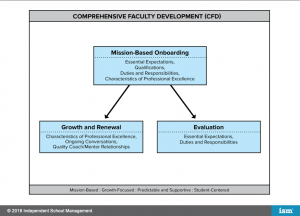 As we begin the close on the year that has been, many of us may be looking to the beginning of next year. Inevitably, this brings with it new staff, onboarding and dedicated professional learning.
As we begin the close on the year that has been, many of us may be looking to the beginning of next year. Inevitably, this brings with it new staff, onboarding and dedicated professional learning.
We need to get this right. We need our new faculty to feel welcome, situated within the culture and confidence in the strategic direction they have joined. As Brene Brown always says: “Being Clear is Kind”. This book has been incredibly helpful in providing insight, strategies and protocols for ideating on this question:
How might we design an onboarding program and professional learning program that provides clarity, support and direction?
You’d be interested in this book if:
1) You wanted to get clear on the role of administration and middle managers in making your school’s onboarding and PL program intentional and aligned with your mission and strategic direction
2) You wanted to ground your onboarding program and PL program in your schools mission and strategic direction
3) You wanted a collection of resources, templates and surveys to use to improve your faculty’s experience
4) You wanted to reimagine your onboarding and PL program given the current climate and uncertainty
1) Provocative Questions from Different Perspectives
This book provides the reader with excellent questions and statements that invite reflection on how to position roles and purposes within the organization. For example:
With the student at the center, the teacher’s question is: “How might I improve to better maximize student performance?… this is the essential purpose for every teacher. (pg. 24)
[Laser focus on enhancing student performance, satisfaction and enthusiasm] requires schools to think differently about managing teacher performance. The first step to thinking differently is to understand the administration’s primary role is not to identify who is a good teacher and who is not, but to grow the entire faculty’s capacity to positively affect students’ success. (pg. 102)
With these questions in mind, readers are encouraged to release the assumptions and structures of their current model and reflect on its purpose.
2) Faculty Characteristics of Professional Excellence (CPE)
This book is grounded in ‘Why’, and I think that many who are reading my blog are well grounded in the why of their schools. What I enjoyed about this section of the book is the striving for a definition that defines the desired direction of growth – the “how”. In order to grow faculty’s capacity, they have to see the direction. The Characteristics of Professional Excellence “describes the qualities each teacher must display to deliver the school’s mission with excellence and produce students who model the Portrait of the Graduate.” (pg. 37)
The portrait of a graduate and the characteristics of professional excellence should mirror each other. The CPE is the “How” that is inspired by and guided by the “Why”.
The book goes into a great process for the development of the CPE as well.
3) Faculty Growth must be separated from Faculty Evaluation
This point cannot be emphasized enough, and it is strongly advocated for, with thoughtful arguments, throughout. I am a proponent of this already, so it was great to have a renewed sense of why this is so important for culture building.
School leadership must be responsible for creating the environment where this uncoupling [of growth and evaluation] if felt by the faculty, instead of just talked about by adminstrators. (pg. 103)
The role of administration is key. Making PL a daily event, where leaders must be:
- Clear with their faculty that PL is NOT evaluation
- Keep the system of growth and development (NOT evaluation) clear and absent of complexity
- That leaders must model and engage with the PL within the school
And embedded within the PL program and onboarding program is the need for accountability. “When teachers are held accountable for meeting Essential Expectations, and given latitude to invent and create practices – rather than simply implementing and adopting mandated school policies and practices, they and their students benefit. ” (pg. 115) So as leaders, it is necessary to ensure that the outlines of the sandbox are clear, and the direction of where faculty spend their creative energy is aligned to the school’s strategic direction.
The book includes other elements, such as assigning compensation and different models to do so (I recommend looking at their approaches to broadbanding), as well as ingredients for a healthy faculty culture. They write: “The ingredients of a healthy faculty culture become evident when the community begins to notice broad-based examples of:
- commitment by the individuals to their own growth and career
- whole-faculty commitment to common goals and purposes
- teachers’ desire to grow in support of one another
- administrators providing high levels of predictability and support, as experienced by the faculty as a whole
They go on to assess measures taken to get to this evidence listed above, and I found this incredibly helpful. It allows leaders to triangulate different experiences, actions towards PL that simplify expectations, and then how these experiences and actions are ‘noticed’ within the community.
I’ll end with this quotation:
Creating a culture of professional growth is a complex endeavor. The environment must encourage frequent conversations about and experimentation in, the practice of teaching. Time for collaborative planning, teaching and peer observation must be emphasized since teacher sand administrators depend on one another for feedback, reflection and support to strengthen the growth process. (pg. 115)
There is a lot in this book, and at times is vacillates between an implementation manual with its detailed templates and guides, and a manifesto of powerful PL and onboarding for independent schools. Both of these approaches are applauded by be!